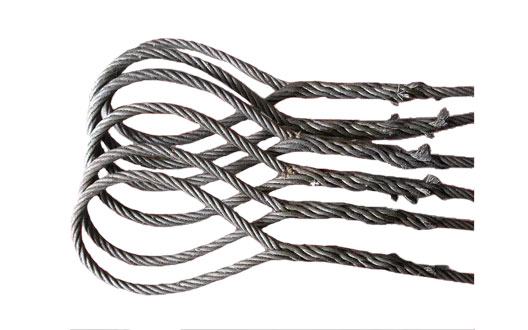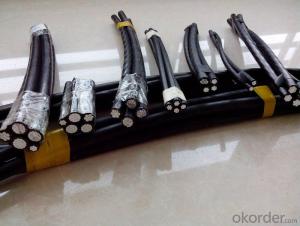High quality steel wire rope
- Loading Port:
- China Main Port
- Payment Terms:
- TT OR LC
- Min Order Qty:
- -
- Supply Capability:
- -
OKorder Service Pledge
OKorder Financial Service
You Might Also Like
A or a plurality of strands of fine steel wire twisted into a flexible rope, wire ropeis composed of several layers of steel wires are twisted into stocks, again with the rope core as the center, a certain number of strand wound into a spiralrope. In material handling machinery, used for lifting, traction, pulling andcarrying with. Steel wire rope has high strength, light weight, stable work, not easy to suddenly the whole root fracture, reliable work.
Steel wire
Steel wire rope to bear the load, its performance is mainly composed of a steel wire decision. Steel is carbon steel or alloy steel by cold drawing or cold rolledinto round (or special) wire, with very high strength and toughness, and according to the use of different environmental conditions on the steel wiresurface treatment.
Rope core
The main effect of rope core is to increase the elasticity and toughness ofsteel wire rope, steel wire, reduce friction and lubrication, improve the service life of wire rope. Commonly used rope core types include organic fiber (such as hemp, cotton), synthetic fiber, asbestos core (high temperature) or softmetal materials.
Classification
Edit
The steel wire rope according to the shape, level, classification of state etc..
Shape
The 1 round strand wire rope
2 braided wire rope
3 flat wire rope
State
The wire rope can also according to shares in the contact state between each layer of steel wire is divided into point contact, line contact or surface contact3.
Wire rope point contact: shares in wire diameter are the same. In order to make the steel stress is uniform, each layer of steel wire twisted around the rear spiral angle of approximately the same size, but the torque range, so the inner layer and the outer layer steel wire cross, in point contact state.
The line contact wire rope: each layer of steel wire strands of screw distance is equal, the inner layer and the outer layer steel wire in contact with each otherin a spiral line, a line contact state. Performance of linear contact lay wire ropes than point contact are greatly improved, so widely used.
The surface contact wire rope: a facial contact strands, the outer layer made of profiled steel wire with smooth surface, good wear resistance, compared with other types of wire rope of the same diameter, tensile strength is big, and can withstand the lateral pressure, but the flexibility is poor, complex process,high cost, often used as a carrying cable. Such as cable of cable crane andthe aerial ropeway.
- Q: What are the different types of steel bars and their uses?
- There are several types of steel bars, each with its own unique properties and uses. Some common types include carbon steel bars, alloy steel bars, stainless steel bars, and tool steel bars. Carbon steel bars are widely used in construction and general manufacturing due to their strength and affordability. Alloy steel bars are known for their exceptional strength and durability, making them suitable for applications requiring high strength and resistance to wear and tear. Stainless steel bars are corrosion-resistant and commonly used in food processing, architectural structures, and medical equipment. Tool steel bars are specifically designed for toolmaking, offering high hardness, toughness, and heat resistance. Overall, the different types of steel bars cater to a wide range of industries and applications.
- Q: How is steel wire galvanized for fencing applications?
- Steel wire is galvanized for fencing applications by immersing it in a bath of molten zinc. This process, known as hot-dip galvanizing, creates a protective coating on the wire. The wire is first cleaned to remove any impurities, then dipped into the zinc bath, ensuring complete coverage. The zinc coating prevents corrosion and extends the lifespan of the wire, making it suitable for fencing applications.
- Q: How is steel used in the production of pipelines?
- Steel is commonly used in the production of pipelines due to its strength, durability, and resistance to corrosion. It is used to construct the main body of the pipeline, providing a sturdy structure to transport various types of fluids over long distances. Additionally, steel pipes can be welded together, allowing for easy installation and maintenance.
- Q: What is the role of steel in the energy sector?
- Steel plays a crucial role in the energy sector as it is used in the construction of power plants, transmission towers, and pipelines. It provides strength and durability to these structures, ensuring their safety and longevity. Additionally, steel is utilized in the manufacturing of wind turbines, solar panels, and energy storage systems, enabling the production and distribution of renewable energy. Overall, steel is an essential material that supports the infrastructure and development of the energy sector.
- Q: What are the advantages of using stainless steel in the food and beverage industry?
- Stainless steel offers several advantages in the food and beverage industry. Firstly, it is highly resistant to corrosion, making it durable and long-lasting. This resistance to rust and staining ensures that the integrity and hygiene of the food and beverage products are maintained. Additionally, stainless steel is easy to clean and sanitize, which is crucial in maintaining a high level of hygiene in food processing and storage. It is also non-reactive, meaning it does not interact with the food or beverages, preserving the taste and quality of the products. Furthermore, stainless steel is heat resistant, allowing it to withstand high temperatures during cooking or processing without warping or degrading. Overall, its strength, durability, and hygienic properties make stainless steel an ideal material for the food and beverage industry.
- Q: How are steel tubes used in the fabrication of hydraulic systems?
- Steel tubes are used in the fabrication of hydraulic systems as they provide a strong and durable material that can withstand high pressure and harsh conditions. These tubes are commonly used to transport hydraulic fluids, such as oil or water, from one component to another within the system. They ensure efficient and reliable flow of fluids, maintaining the system's functionality and performance. Additionally, steel tubes can be bent, cut, and welded into various shapes and sizes, allowing for customization and easy installation in hydraulic systems.
- Q: How is steel rebar reinforced in concrete structures?
- Steel rebar is reinforced in concrete structures by placing it strategically within the concrete, typically in a grid-like pattern. The rebar is then securely tied or welded together to provide additional strength and stability to the structure. This reinforcement helps to distribute the load and prevent cracks or failures in the concrete, ensuring the overall durability and resilience of the structure.
- Q: How does steel reinforcement work in concrete structures?
- Steel reinforcement works in concrete structures by enhancing the overall strength and durability of the concrete. It consists of steel bars or mesh that are embedded within the concrete to provide tensile strength, which is lacking in concrete alone. When subjected to tension, the concrete tends to crack or fail, but the steel reinforcement helps to distribute and resist these forces, preventing the cracks from propagating. This combination of concrete and steel reinforcement creates a composite material that can withstand a wide range of loads and environmental conditions, ensuring the structural integrity and longevity of the concrete structure.
- Q: What are the different types of steel chains and their uses in agricultural machinery?
- There are several types of steel chains commonly used in agricultural machinery. These include roller chains, leaf chains, and agricultural chains. Roller chains are the most widely used and are commonly found in tractors, combines, and other farming equipment. They are used to transmit power from the engine to various components, such as wheels, blades, or conveyors. Leaf chains are often used in heavy-duty applications, such as in balers or harvesters, where they provide reliable lifting and pulling capabilities. Agricultural chains, on the other hand, are designed specifically for agricultural machinery and are used for tasks like crop harvesting, sowing, or irrigation. These chains are usually resistant to corrosion and wear, making them suitable for outdoor and demanding conditions.
- Q: What are the different surface finishes available in steel products?
- There are several different surface finishes available in steel products, including mill finish, brushed finish, polished finish, galvanized finish, and coated finish. These finishes enhance the appearance and provide varying levels of protection against corrosion and wear.
Send your message to us
High quality steel wire rope
- Loading Port:
- China Main Port
- Payment Terms:
- TT OR LC
- Min Order Qty:
- -
- Supply Capability:
- -
OKorder Service Pledge
OKorder Financial Service
Similar products
Hot products
Hot Searches
Related keywords




























